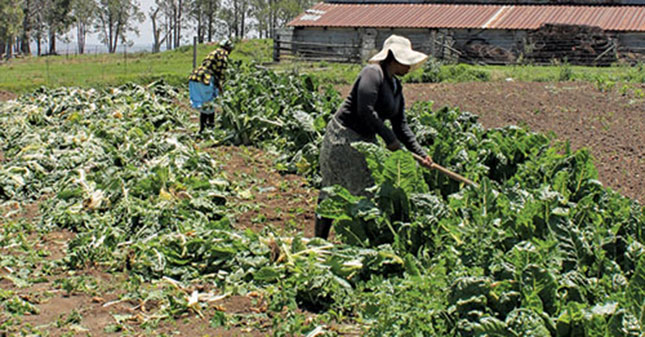
Photo: FW Archive
How will the Land Bank enhance its operations through collaboration with other development finance institutions (DFIs)?
As a rule, we work in partnership with other DFIs and relevant institutions to address the challenges faced by our farmers. We’ve enhanced the benefits of these relationships in our recent strategy; they are a critical part of extending our reach to the customer base. On infrastructure development, we will work with institutions such as the Development Bank of Southern Africa to look at areas such as expanding bulk water and irrigation schemes.
In agro-processing, we’ll work in collaboration with the Industrial Development Corporation (IDC), which has a mandate to drive an increase in export growth capacity. On BEE, we will work with the National Empowerment Fund (NEF) and other broader government stakeholders to drive inclusive growth and increase the participation of black farmers within the market.
How much was spent on reducing non-performing loans in the period under review? How will that be managed?
Despite the significant growth in its loan portfolio over the last five years, the bank has managed to keep its ratio of non-performing loans (NPLs) within acceptable levels relative to its portfolio size (3,7%). However, the bank is wary that NPLs could increase in the short to medium term if prevailing economic conditions continue.

The strategy is to approach our book on a more holistic basis through portfolio management. This will ensure that we are pro-active, hands-on, and that we ensure access to technical advice to mitigate any possible risk. As a development finance institution, this support is critical.
What are the bank’s plans to continue increasing its operating income, seeing that it secured R762,8 million (2015), up from last year’s R737,4 million?
The bank is aware of the need to increase its operating income to continue to support its strategy of driving inclusive growth of the sector. In the main, this growth will be derived from:
- Continued loan book growth. We will continue to grow the number of the participants in this sector by funding new entrants to the market;
- Different financial instruments designed to increase our portfolio exposure into new areas. For example, equity will also be considered where required;
- Diversification beyond primary agriculture, towards agro processing-related opportunities.
It is envisaged that this combination of development solutions will increase our participation in the sector. In particular, this will drive different mechanisms for sourcing and including black emerging farmers into the sector.
Operating expenses in the 2015 financial year declined from those of 2014. What contributed to this and how do you plan to sustain it?
Overall, the bank’s operating expenses decreased by 2,9% or R15,3 million (R525,8 million in 2013/2014). We’re glad to have achieved this magnitude of reduction on the operating costs. This was largely due to reduced personnel costs and a focus on general cost containment as an ethos. We hope to continue managing this trend in the future. The bank is also hoping that the process of reviewing the organisation will deliver better efficiency gains, among other outcomes. This project is currently underway.
How does the bank plan to navigate around the issue of the title deeds in rural areas where the communal land system is in place?
The policy on land tenure is evolving in the country. As a bank, we require security of tenure to be assured. In seeking that assurance, we will become innovative in our approach. We continue to explore alternative models of securing investments by the utilisation of different methods of categorisation of land ownership.
Do you fund emerging farmers who farm in such a setting?
Yes, the REM (retail emerging markets) model was an instrument specifically designed to address this. It has been successfully implemented in Mpumalanga and the Karoo, and has achieved notable success and low NPLs through strong commercial partnership support.
The land is owned by the tribal authority, so who provides security for them?
We had to be innovative in our considerations for our assurance and our security. In some instances, the bank used an SPV (special purpose vehicle) structure to provide governance support and market structure. This has enabled it to support a different profile of a farmer, through a risk-based governance tool and at the same time, secure our investment.Tools such as cessions and securing off-takers are a critical part of the strength of this model.
We will continue to challenge ourselves to find development solutions to growing an inclusive agricultural sector. We have achieved success. This level of innovation will continue, and must form our unique contribution to the development agenda.
Industry stakeholders such as Afasa are not happy with the bank’s funding model. They feel that attention is not being given to emerging black farmers. How do you plan to debunk this?
We have identified inclusive growth as a pillar in our strategy. This aims at increasing the size of the agricultural sector contribution to the economy through funding new entrants, and increasing the proportion of black emerging farmers that farm at scale either through expanding their farm sizes or their productivity. We want to increase this through areas such as new farm development and expansion projects, among others.
What are the bank’s goals for the coming financial year?
As indicated, the bank has developed a new business strategy through which we’ll be undertaking exciting initiatives. These should enable us to meet the great expectations of the market and shareholders. They are categorised into the following strategic pillars:
- Growth sector support: Accelerate high-potential regions and align with the most relevant crops.
- Supply chain development: Focus on areas such as greenfield agro-processing with partners such as IDC.
- Production expansion and intensification: Focus upon supporting the next-generation farming. Tailored products will be critical to drive expansion in this area.
- Agri-innovation: The focus will be on spurring agri-innovation concepts that have the potential to catapult and change the sector.
At the Nerpo AGM, you pleaded with delegates to have patience with the new Land Bank management team, saying you were aware of inconsistencies such as the high turnaround time for processing funding applications. How will you address these?
We’re in the middle of an organisational review. In this, we have reviewed our critical processes with a view to streamlining decision-making and improving areas such as turnaround time.
At the top of this list is a review of the credit process which affects our clients the most. We’re confident that with proper implementation of these changes, the bank will deliver better services in the near future.
Do you have any final thoughts on the Land Bank?
The bank remains a significant institution to enable the development of agricultural sector. We’re keen to take it to sustainability level. Such a journey will succeed only with the support of our clients, stakeholders, shareholders and committed employees.
For more information, phone Gugu Gowera of Magna Carta, who handles public relations for the Land Bank, on 011 748 2598 or 082 344 6454.
This article was originally published in the 6 November 2015 issue of Farmer’s Weekly.













